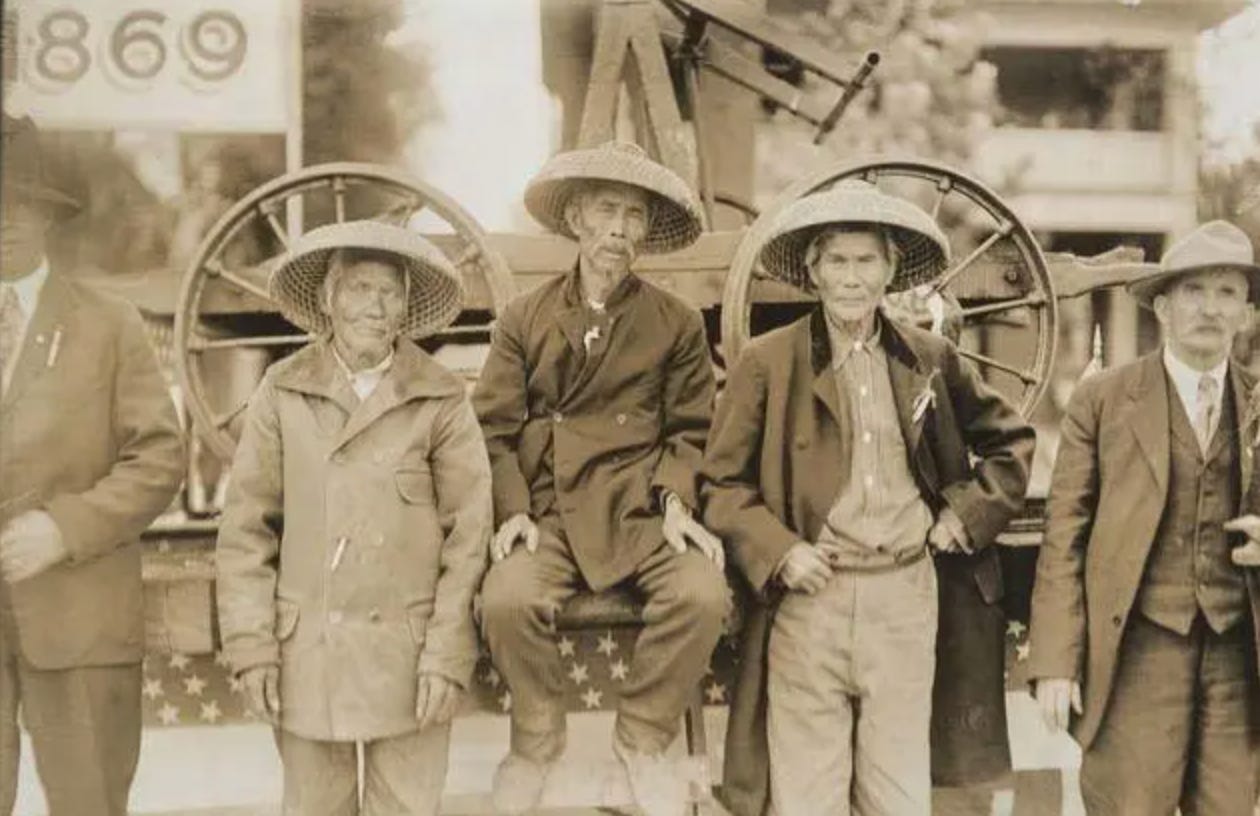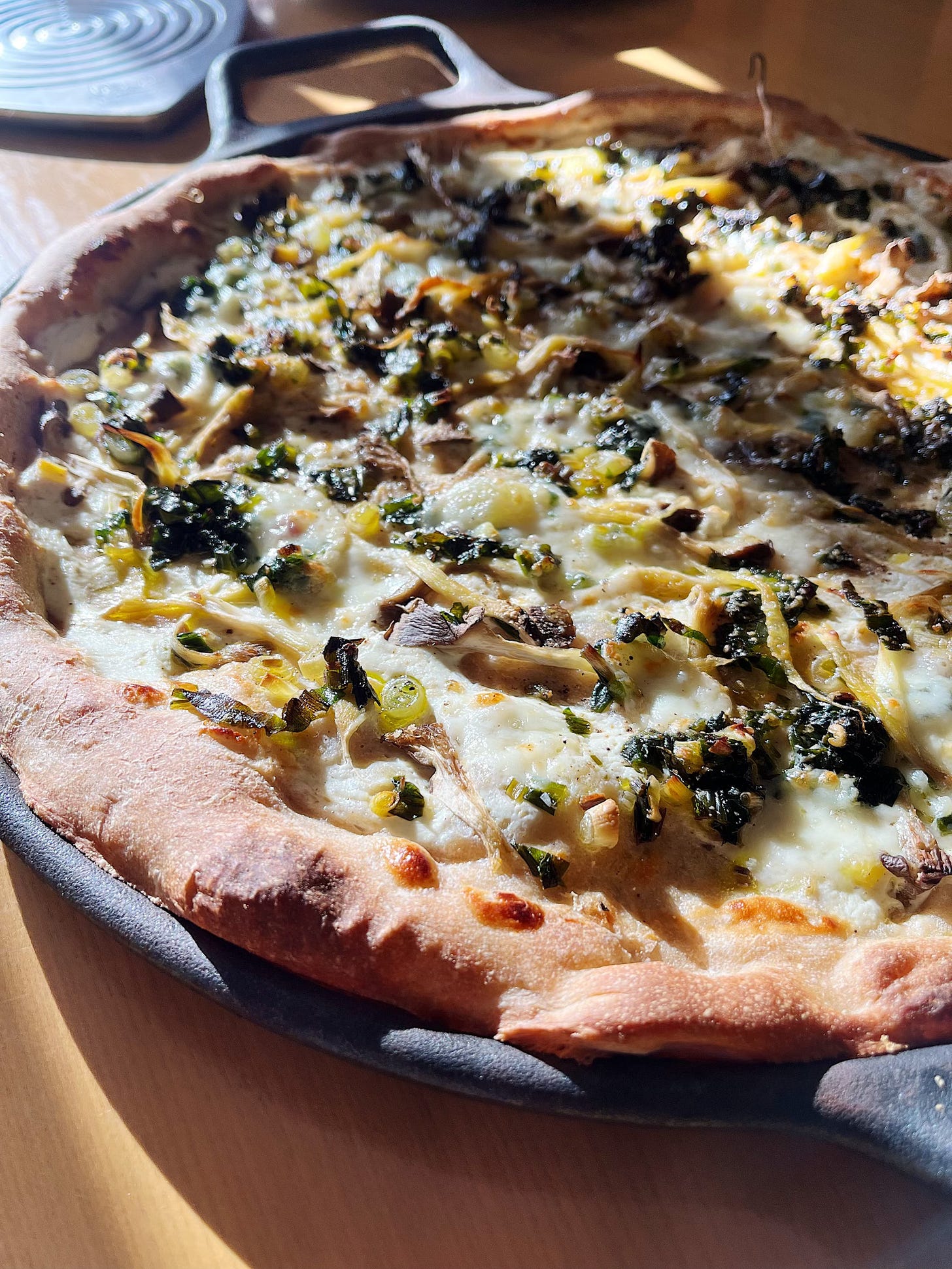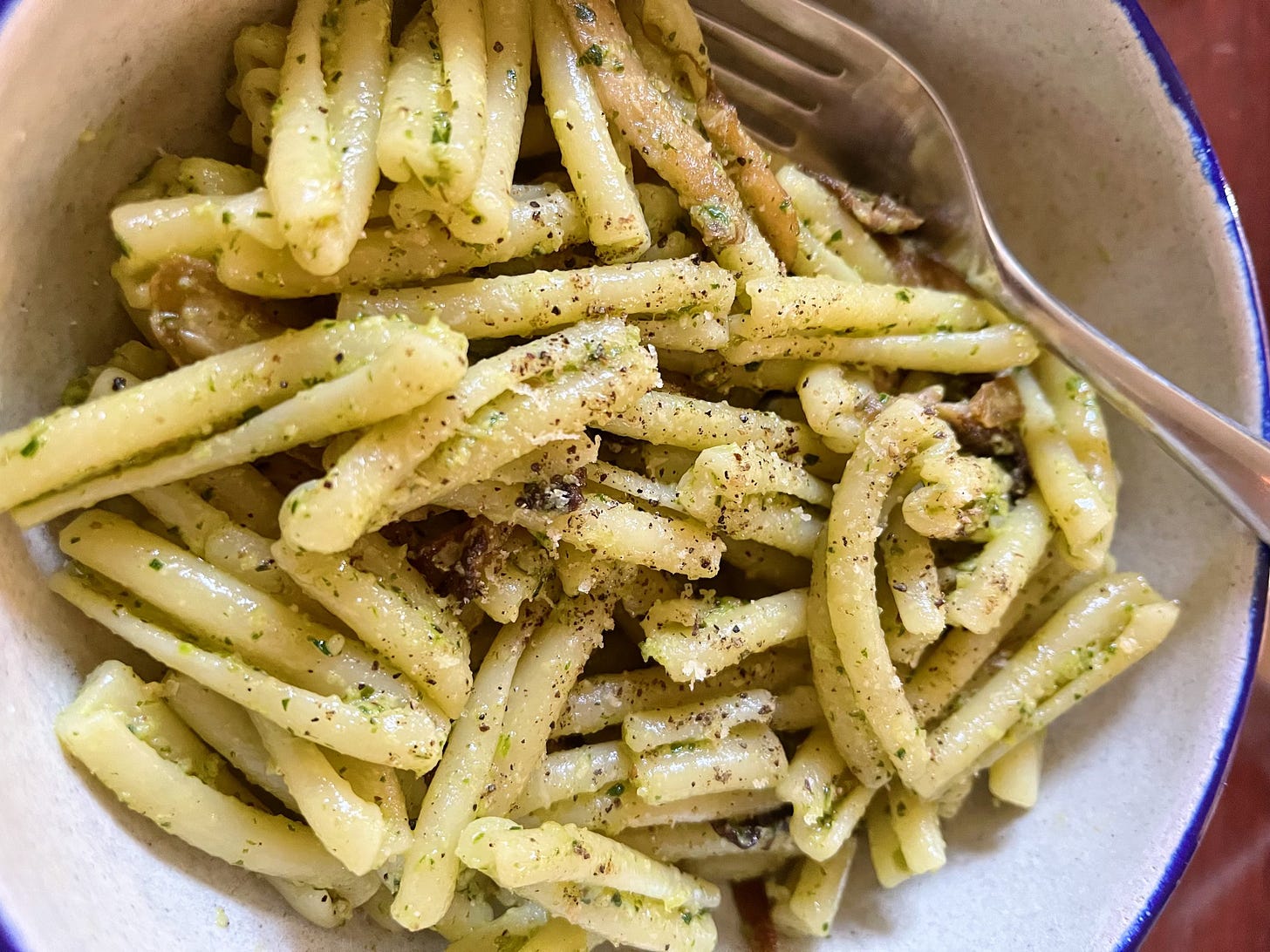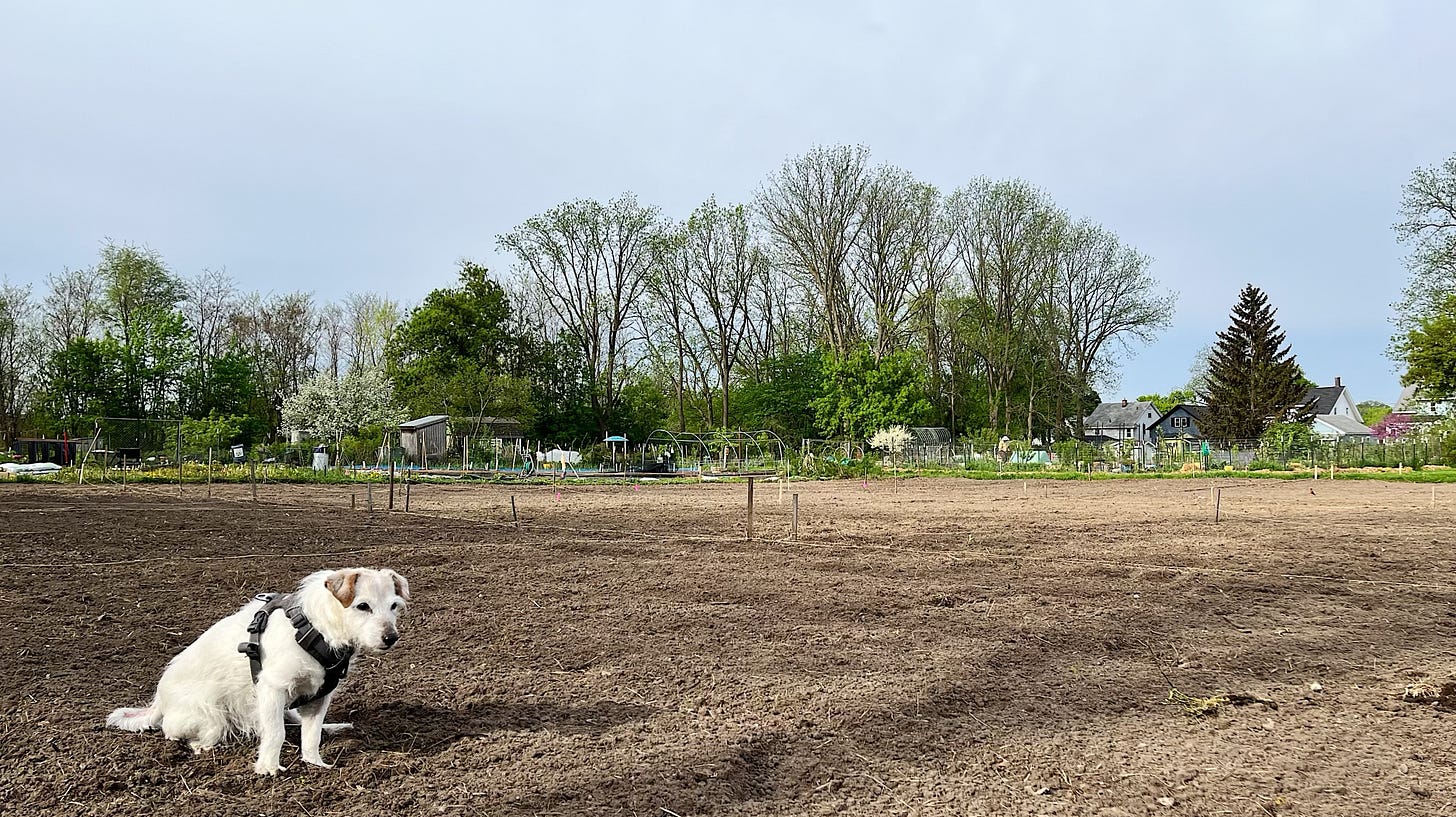Come What May
Some fragmented thoughts on Asian American/Native Hawai'ian/Pacific Islander Heritage Month, the lie of invisibility, ramps, and gardens
Friday, May 12
Grand Rapids, Mich.
The other day at church, someone asked me: If you could eat just one dish—one dish that defines comfort food for you—what would it be?
He didn’t have to finish asking the question for me to know my answer: fried rice.
Fried rice was a beloved staple in my childhood home. My mother would typically prepare it with the previous night’s rice, along with whatever leftover meat we had in the fridge—remnants of roast duck, shreds of soy-sauce chicken; my grandmother favored lap cheung, the slight sweetness of the Chinese sausage lending contrast to the savory and the umami. There were always greens, perhaps Chinese broccoli or spinach. Even wilted scallions or a couple of shriveled mushrooms could find a happy home in the dish. Invigorated with egg and soy, fried rice sings of resurrection.
But once a year, my mom made a giant batch of fried rice using ingredients we never ate ourselves: diced, canned ham and frozen peas and carrots. She would cart vats of the stuff to a school fundraiser called Family Fun Day. We were one of the only Chinese families in the entire K-12 school, and my mom became well known for this fried rice, which always sold out. Once, when I asked why she made it this way, she said, It’s how they like it.
I came to loathe that version of my mom’s fried rice, and recently, I realized that I loathe it for the same reason I dread the month of May. Each year when Asian American/Native Hawaiian/Pacific Islander Heritage Month rolls around, many of us try to make ourselves palatable to others. We raise our voices in the hopes that we will be heard. We reshape ourselves in a bid for belonging.

During the bicentennial celebrations of the United States in 1976, congressional aide Jeanie Jew was struck by the erasure of Asian American contributions to the nation’s history. The following year, Jew, the great-granddaughter of a Chinese immigrant who had helped to build the Transcontinental Railroad, went to her boss with an idea: Beginning in 1968, the U.S. had recognized Hispanic Heritage Week, and in 1976, President Gerald Ford designated February as Black History Month. How about a similar commemoration centering Asian Americans?

In 1978, acting on a congressional resolution co-sponsored by Jew’s boss, Rep. Frank Horton, Republican of New York, and Rep. Norman Mineta, Democrat of California, President Jimmy Carter designated the first week of May as Asian/Pacific American Heritage Week. In 1990, Congress expanded the occasion to the entire month. Today, May is officially celebrated as Asian American, Native Hawaiian and Pacific Islander Heritage Month.
Jew’s goal was laudable. She rightly recognized that people of Asian and Pacific ancestry have contributed mightily to U.S. history—and that those contributions have been largely overlooked. So, too, our suffering: Jew’s great-grandfather, M.Y. Lee, who eventually became a businessman, was killed in Oregon during a period of heightened anti-Asian violence in the late 19th century. The designation of a celebratory season was meant to raise the visibility of and respect for Americans who trace their ancestry to Asia and the Pacific islands.Has it worked?

Here we are, nearly a half-century later, and the marginalization of Asian and Pacific Islander Americans remains present in big and small ways. The number of reported anti-Asian hate crimes in the U.S. has surged tremendously over the past several years. In research released last year by the National Asian Pacific American Women’s Forum, 74% of those polled—and 80% of Native Hawaiian and Pacific Islander women surveyed—said that they had personally experienced an incident of racism or discrimination in the previous year. The 2022 STAATUS Index, which measures perceptions of Asian Americans, found in a survey of more than 5,000 Americans that 58% could not name a single Asian American public figure. Among the 42% who did venture a guess, the most popular answer was the film star Jackie Chan, who is not American; two other non-Americans also made the top 20: Kim Jong-Un and Jet Li. Significantly more of those polled for the 2023 STAATUS Index were able to offer a name, yet Jackie Chan was still the No. 1 answer.
As an essayist, I have found that, anytime I write explicitly about my heritage, engagement tends to drop—fewer emails from readers, fewer shares, fewer likes. (The exception to the pattern: anytime I include a recipe for a Chinese dish.) As an author, I’ve been told by literary agents that I must make my writing more culturally relatable and less foreign; because most readers won’t share my heritage, “you have to make clear to the reader how you’re helpful,” one told me. As a public theologian, I am often invited to preach in churches all over the country. Even in the most progressive congregations, it’s rare that I can get out the door without being asked some version of that hoary old question: “No, where are you really from?”
If AANHPI Heritage Month is meant to boost belonging and combat invisibility, I’m not sure it’s doing the job. Every year, when this month rolls around, I see people of Asian and Pacific heritage posting on social media about “our month”—and a whole lot of nothing from pretty much everyone else. A month designated to celebrate our presence serves only to accentuate our marginalization.
Anyway, there’s a problem with the idea of invisibility: It unwittingly makes us the problem. It puts the onus of visibility on those who are unseen. If only we were more prominent, if only we celebrated ourselves in ways that made sense to others, if only we had a week or a month for us, we would be seen. But there’s a difference between invisibility and being unseen.
We are not in fact invisible. Others simply choose not to see us. And I’ve lost hope that those of us of Asian, Native Hawai’ian, and Pacific Islander heritage will ever be valued as equal—as fully American—by broader society. I doubt other Americans will ever see us and believe that we truly belong.

A few years ago, as we were embroiled in the discord of the 2020 presidential-election season and Donald Trump ramped up his anti-Chinese rhetoric, I posted something on Facebook about my lack of belonging and my sense of alienation in this country. An irked parishioner confronted me: Shouldn’t you feel more grateful? he asked. It seems like you’ve had a lot of opportunities in this country.
Indeed I have. Especially as the son of a U.S. Army veteran who was born in Hong Kong and who fought in Vietnam, I am deeply grateful—and I am proud of all that we who trace our ancestry to Asia and the islands of the Pacific have done to make the United States what it is.
And also? Gratitude for what we have can coexist with grief for promises unfulfilled. Because of my love for this country, not in spite of it, I wish for a more perfect union, as the founding documents of the United States pledge: peace, which means justice, which means equality, not just for Asian Americans but also for those who are Black and Latino and multiracial and queer and trans and disabled and poor and otherwise on the outskirts.
I’m not sure I have much hope left, though, for true belonging—or perhaps my understanding of belonging is shifting.
Last year, I had a conversation with the Hong Kong-born theologian Kwok Pui Lan, who teaches at Emory. She told me that wherever she goes, she has learned not to expect belonging to be extended to her. “So,” she said, “I create my own belonging.”
That comment moved me.
“It’s how they like it,” my mom said about the fried rice. What if it didn’t matter whether they liked it? What if it were enough that we liked it? What might it mean for us to love ourselves and our peoples and our cultures as we are, even if others fail to celebrate us or even recognize us? Professor Kwok’s simple but profound statement helped me to understand that the most important mattering is the belonging that we cultivate authentically ourselves.
So I am choosing to mark this May as just another May. I will celebrate my Chinese heritage, but I will do that not just this month but every single day of the year.
I will celebrate by continuing to honor my ancestors through my storytelling. I will celebrate simply by existing in this Chinese American body. I will celebrate by reading the poetry and prose of AANHPI writers and inhaling the cuisine of AANHPI chefs and rejoicing in the wondrous creativity of so many AANHPI siblings, even as I bristle at the ridiculousness of lumping all of our diverse cultures into the shorthand AANHPI. I will celebrate by cooking the dishes I learned from my mother and my grandmothers—including fried rice made our way—not just this month but every single day of the year.
I will celebrate not for the sake of visibility to other Americans or for the validation that might never come, but simply because we are beautiful and we are worthy and we have the power to create our own belonging. We need to hold onto those truths, not just this month but every single day of the year.
What I’m Cooking: We’ve been trying to eat vegetarian at least a couple of days a week. Fortunately, springtime has brought an abundance of delicious options.
Ramps came in at the farmers market last week, as did green garlic. So we made pizza for the first time in a long while, and I did a white pie (Greek yogurt, mozzarella, parmesan) topped with ramps, green garlic, and oyster mushrooms. (Dough recipe, from Joe Beddia of Pizzeria Beddia in Philadelphia, can be found here, but I highly recommend buying his cookbook, Pizza Camp. I pre-heat my cast-iron pan for half an hour at 500 degrees Fahrenheit, bake for about four minutes, and then broil for a few more minutes until it all looks done.)
Then I made the first fresh pesto of the season—ramps and green garlic, parmesan and walnuts, basil and a little bit of baby kale, plenty of good olive oil, a squeeze of lemon juice, and fresh cracked black pepper. We still had some oyster mushrooms left, so I chopped up and pan-roasted those and threw them in.
What I’m Growing: The community garden opened today, so now the hard work begins. Fozzie and I went earlier today to check out our plot. While he ate dirt, I planted a few flowers. The next week will be a flurry of activity: We have mulch and compost to cart over, and plenty of seeds to sow.
What I’m Reading: We decided to leave our yard unmowed for May, which, we’re told, helps give the pollinators a head start. As the grass has grown, we’ve been visited by bumblebees and butterflies. And I’ve also seen how “grass” is such an insufficient term for all that has come up: Kentucky bluegrass and ground ivy, red sorrel and sandwort, clover and meadow violet. So I appreciated this piece in the Reformed Journal by Jen Holmes Curran, a pastor here in Grand Rapids. She writes of all that she is learning about the living communities around her: the trees and the grasses, the natives and the invasives. She testifies to a sort of grief that comes with realizing what you’ve been ignorant to, but at the same time, there’s an invitation and an opportunity. “We cannot love,” she writes, “without knowing.”
Since I began with fried rice, let me end with an essay on food. Ligaya Mishan has a thoughtful essay in T: The New York Times Style Magazine that explores a question that I’ve long wondered: Why do so many Americans struggle with foods of different textures? Her exploration ranges widely. I was especially struck by her hypothesis that a generation reared on processed food came to develop a palate for “food that simply obliged. Gone were the textures of resistance... the messy ones that call to mind a body’s murky interior, that remind us where our food comes from.”
Those of you who have been with me for some time know that I have written about fried rice before—and yes, I have something of a recipe.
Every cook makes fried rice differently. My paternal grandmother typically cracked her eggs over the rice toward the end, which is how I do it; my mom often scrambles the eggs first. And despite my opposition to peas and carrots in fried rice, I won’t go so far as to say it’s wrong to include them. If you’ve made fried rice using my guidelines, I’d love to know how it turned out—and if you wish, email me a photo (makebelievefarmer@gmail.com)!
As always, I’m so grateful we can stumble through all this together, and I’ll try to write again soon.
Yours,
Jeff








Jeff, I hope I can give you some encouragement about being seen and accepted. I have kids in high school and maybe it's because we live in a pretty liberal town but I don't think that's it-most of the kids seem to really accept each other and love learning about each other's backgrounds. It's not to say that there aren't tensions sometimes but this GenZ gives me so much hope. Perhaps because they grew up with social media (which can be terrible) but they are so much more accepting of differences than any generation I've seen in my lifetime. (I'm an older GenXer and I'm Cuban American and understand how crappy it is to be lumped into one big group. We do get Hispanic Heritage Month but depending on what country you come from, we can be vastly different.) It is not a consolation but I deeply believe that the rise in hate crimes is a direct result of people who are afraid of the change that is happening in our country and for the most part, it is really GOOD change! My teens and their friends are not afraid of people of different ethnicities, races, etc. My mother who is 95 years old and grew up in very different times has been in awe of my kids' friends groups. She says it looks like the United Nations when they are all together--and it's Beautiful!
I love that line about creating your own belonging. There's something very powerful in that - thank you.